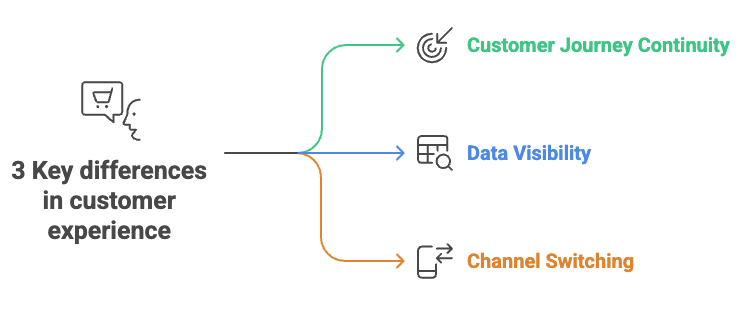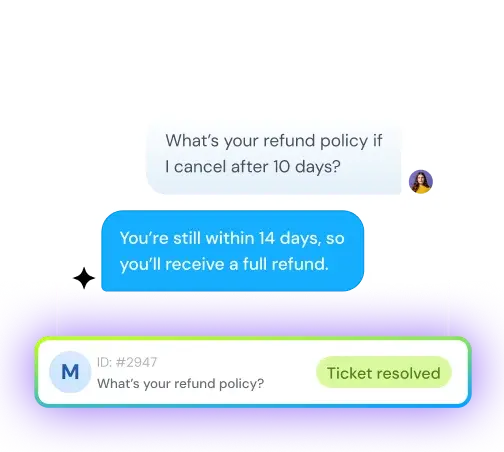Omnichannel Vs multichannel customer service: Complete breakdown
Vaishali Jayaprakash
Sep 22, 2025

The choice between omnichannel vs multichannel customer service represents two completely different customer experiences. Your customers' expectations are clear- consistent interactions across all departments.
The way you connect with customers across channels has never been more important. Customers involve themselves on platforms of all types - from websites and mobile apps to physical locations. The difference between multi vs omni channels extends beyond platform presence. Even with multichannel service options available, customers struggle to switch between channels while seeking support.
Customers often find the multichannel experience disconnected. About 55% feel they're dealing with separate departments instead of a single company. Instead of this fragmented approach, omnichannel creates an uninterrupted, customized experience as customers move between email, SMS, web, and other touchpoints.
Here's a simple way to look at it: multichannel puts you where your customers are, while omnichannel weaves these touchpoints into one smooth experience. This piece explains everything about these approaches to help you choose what works best for your business.
What is omnichannel vs multichannel customer service?
The difference between multichannel and omnichannel customer service will help you make better decisions about your customer experience strategy. These terms might sound alike, but they represent two completely different service philosophies.
Definition of omnichannel customer service
Omnichannel customer service blends all communication channels into one unified system. This approach goes beyond just offering multiple contact options - it connects every touchpoint to create continuous communication that follows customers everywhere.
Your customers' conversation history and context move with them from one channel to another. A customer might start chatting online and later call your support line. Your agents can see all previous interactions right away without asking the same questions again. Research shows that 87% of customers get frustrated when they must repeat themselves on each new channel.
Definition of multichannel customer service
Multichannel customer service lets customers reach your business through multiple communication channels. Your customers can connect through phone, email, social media, live chat, and SMS. The approach puts your business wherever your customers are and gives them the freedom to choose how they want to connect.
Each channel in a multichannel strategy works independently. Picture these channels as parallel roads that never cross paths. Customers can pick their preferred way to reach you, but each platform works alone with minimal information sharing between them. Customers often need to start over when they switch platforms because their conversation history doesn't follow them.
Core difference: siloed vs integrated channels
Channel integration marks the main difference between these approaches. Multichannel focuses on providing various support pathways. Each channel works on its own, which creates silos that limit your ability to give customers the best experience.
The customer sits at the heart of omnichannel support, which creates a smooth experience whatever way they choose to interact. Unlike multichannel's disconnected approach, omnichannel breaks down barriers by bringing together customer data from every touchpoint.
A real-world example shows this difference clearly. In multichannel support, an email conversation and a social media chat exist as separate interactions. But omnichannel lets customers start talking on one platform and continue somewhere else without missing a beat - much like a highway system where drivers can switch routes easily.
Omnichannel also helps your team create tailored experiences based on complete customer data. This unified system makes things smoother not just for customers but for your support agents too.
3 Key differences in customer experience

Your customers' daily interactions with your brand show the true difference between multichannel and omnichannel strategies. These approaches create two very different customer experiences that go beyond simple definitions.
Customer journey continuity: fragmented vs seamless
Multichannel creates separate touchpoints that leave customers confused as they move between platforms. Each interaction stands alone, and customers must start fresh every time they switch channels. Data shows that over half of organizations have at least 11 systems of siloed data, which makes it hard to give customers a consistent experience.
Omnichannel customer service lets customers move smoothly between touchpoints while keeping their conversation history intact.
Here's a real-life example: A customer looks at products on your website and adds items to their cart before visiting your store. The store staff can't see any online activity or customer priorities in a multichannel setup. The customer has to explain everything again, which feels disconnected. But with omnichannel, staff can see browsing history and priorities right away, giving a tailored experience.
Data visibility: isolated vs unified profiles
Multichannel support usually creates blind spots across channels. Each department only sees pieces of customer information through its specific view. Support agents can't give informed responses or personalize service without the full picture.
Omnichannel combines data from every interaction point into unified customer profiles. These detailed profiles give your team access to the complete 360-degree view of each customer. This complete picture helps you understand behavior patterns, predict needs, and give proactive service.
On top of that, it adapts content and offers based on customer actions through up-to-the-minute data analysis. This quick response helps boost conversion rates through relevant, contextual interactions.
Channel switching: manual vs automatic handoff
The biggest difference shows up when customers switch channels. Multichannel systems make customers repeat their story. To name just one example, see what happens when a customer reaches out on Facebook and later by email - they must explain everything again because email agents can't see the social media conversation.
Omnichannel fixes this problem with automatic context transfer. Conversation history moves with customers across channels, so support teams start exactly where the last interaction ended. Customers never hear "can you explain your issue again?"
The core team also gets shared dashboards showing all client interactions across touchpoints. This complete view encourages better team collaboration and leads to more informed, tailored responses whatever channel customers use.
Pros and cons of each approach
Both customer service approaches give your business different advantages and challenges. You can make the right choice by exploring these differences based on your needs and resources.
Multichannel pros: flexibility, lower cost, faster setup
Multichannel customer service excels in accessibility and simple implementation. You need less money to start with multichannel support compared to omnichannel solutions. The setup process moves faster because you don't need connected systems to launch your customer service channels.
This approach lets you test different messages and strategies independently on each channel. Your marketing and support teams can improve individual channels based on their strengths without worrying about cross-channel integration.
Multichannel works better for businesses with limited technology resources or budget constraints. Local service businesses building awareness find it helpful. B2B companies using LinkedIn and direct outreach, or companies running separate campaigns for different customer segments benefit from this approach.
Multichannel cons: inconsistent experience, limited data
Multichannel support creates customer experience challenges despite its benefits. The biggest problem is inconsistency—customers get disjointed experiences when switching between channels. Studies show 55% of consumers think companies need more consistency in service across channels.
Data limitations make multichannel service harder. Information stays isolated across different channels, and only 14% of businesses get a complete view of their customer data. This separation prevents thorough analysis and individual-specific experiences.
Your support teams find it hard to maintain service quality across all platforms without integrated tools. There's also a higher risk of losing customer questions.
Omnichannel pros: personalization, loyalty, efficiency
Omnichannel customer service creates powerful personalization by combining customer data from all touchpoints. This merger enables individual-specific experiences that customers expect. This personalized approach builds stronger relationships and improves customer satisfaction.
The effect on loyalty stands out—companies with strong omnichannel customer engagement retain the majority of their customers. Companies with weak strategies retain very less. Customers also spend more with omnichannel retailers. Your support agents handle issues faster with complete customer context available. This improved efficiency cuts operational costs and speeds up resolution times.
Omnichannel cons: higher cost, complex implementation
Setting up omnichannel service needs substantial upfront investment in integrated technology, cloud-based platforms, and CRM software. These costs can be too high for smaller businesses with limited resources.
Technical complexity poses another challenge. A successful omnichannel setup requires system integration and elimination of data silos. You need specialized expertise and careful planning to make all components work naturally together.
Staff training adds another challenge. Your team needs cross-channel skills and knowledge of integrated tools. Even well-designed omnichannel systems might fail without proper training.
4 Implementation challenges and considerations

Moving from theory to practice shows substantial hurdles in implementing multichannel vs omnichannel customer service systems. These challenges help determine which approach works best for your business situation.
Technology integration and infrastructure
Strong technical integration across multiple systems makes omnichannel service work. Contact centers often use legacy platforms that weren't designed to make channels work together smoothly. This creates major barriers. Agents spend much of their time learning these systems whatever their experience level.
Multichannel setups have fewer technical hurdles at first but hit limits later. Each channel stays isolated without proper API connections, which prevents a unified view of customers. Your technology stack needs several connected parts to succeed with omnichannel—CRM, contact center software, messaging platforms, and data management tools must work together.
Data management and compliance
Data silos create major obstacles for both approaches, especially with omnichannel strategies. Only 14% of businesses achieve a complete customer view because information stays fragmented. Data quality, consistency, and security become more complex as channels multiply.
Privacy regulations add complexity to the mix. Companies must handle customer data across channels while following regional data protection laws. This often needs dedicated compliance resources, especially with global customers.
Staff training and organizational alignment
Channel management needs specialized training. Multichannel agents typically need expertise in specific channels. Omnichannel sets a higher standard—staff must understand all channels plus the connected systems that link them. Gartner research shows agents avoid using new technologies without proper guidance and practice.
The core team's alignment might be the biggest challenge. Industry experts say "omnichannel support requires a cultural change within the organization". Breaking departmental silos needs efficient workflows where marketing, sales, support, IT, and service teams share ownership of the customer experience.
Cost and scalability concerns
The approaches have substantially different investment costs. Multichannel needs less money upfront but can have "hidden costs due to inefficiencies" later. Omnichannel implementation usually needs bigger original investments in technology, integration, training, and process changes.
Each model faces unique scalability challenges. Multichannel systems get harder to manage as they grow and need more coordination across separate platforms. Omnichannel offers better long-term scalability through unified management. The system's performance across all touchpoints needs careful planning during expansion.
How to choose the right strategy for your business
The choice between multichannel and omnichannel customer service depends on your business's specific needs. Several key factors can help guide your decision.
Business size and customer expectations
Your business's scale points to which approach works better. Small businesses do well with multichannel solutions because they're easier to implement and manage. Large enterprises with complex customer bases usually need omnichannel's integrated features. Your customers' channel-switching habits matter too. Omnichannel might be essential if they frequently switch platforms during their experience.
Market expectations vary widely. Most modern shoppers just need customized experiences.Your target audience's preferences will show if they value omnichannel's smooth transitions or prefer expert support through specific channels.
Industry-specific compliance needs
Some industries must follow stricter rules than others. Healthcare and financial services must comply with complex data protection laws like HIPAA or PCI DSS. Data protection shapes purchasing decisions for most consumers.
Highly regulated industries often benefit from omnichannel systems' strong compliance frameworks through centralized data management. This setup helps track consent, disclosures, and sensitive information better across all contact points.
Current tech stack and future goals
Your existing technology setup affects how hard implementation will be. Companies using older systems might find multichannel approaches easier at first. Your current tools' integration capabilities matter - very few businesses have a detailed view of their customers because of scattered information.
Your customer service strategy should line up with long-term business goals. Omnichannel usually grows better with your business despite higher startup costs. Your priorities between getting new customers or boosting service quality will shape this choice.
Budget and resource availability
Money often decides what's possible. Multichannel costs less upfront but can cost more through inefficiencies. Omnichannel needs bigger initial spending on technology integration, training, and process changes.
Resources go beyond just money. Omnichannel setup needs special expertise and more staff training across contact points. Take a hard look at your available resources before choosing either approach.
Comparison Table
Aspect | Multichannel customer service | Omnichannel customer service |
Simple Definition | Multiple standalone communication paths (phone, email, social media, chat) that operate independently | Integrated system that connects all communication channels into one unified experience |
Channel Integration | Channels operate in isolation with limited data sharing | All channels connect with continuous data flow |
Customer Experience | Fragmented experience where customers must restart conversations when switching channels | Continuous experience at all touchpoints where conversation history follows customers |
Data Management | Separate channels store isolated data with limited visibility | Unified customer profiles provide a 360-degree view |
Customer Context | Agents view only channel-specific information | Agents access complete interaction history from all channels |
Implementation Cost | Lower original investment | Higher upfront costs |
Setup Complexity | Simple setup with less complexity | Complex implementation that requires extensive integration |
Customer Retention | Lower retention | Higher retention with strong participation |
Staff Training Needs | Each channel requires specific expertise | Teams need proficiency in all channels |
Best Suited For | Small businesses with limited budgets and simple operations | Large enterprises with complex customer bases |
Key takeaways on omnichannel vs multichannel customer service
Your brand's customer experience depends on choosing between multichannel and omnichannel service. Multichannel puts you on separate channels where customers are. Omnichannel turns these touchpoints into one smooth customer trip. This difference matters a lot since most of the customers want their interactions to stay consistent across departments.
Multichannel comes with quick setup and lower original costs. Yet it creates fragmented experiences where customers must start over when they switch platforms. Teams can't deliver tailored service because data stays in separate silos. So only very few businesses get a complete view of their customer data through multichannel systems.
Omnichannel breaks these barriers down. Customers switch between channels easily while their information follows them. This smooth experience creates loyal customers.
Look at your business size, customer needs, and technical abilities before deciding. Small companies with limited resources might start with multichannel and integrate later. Large enterprises that have complex customer bases need omnichannel's unified approach right away.
Note that both strategies need careful planning. The right choice should match your current abilities and future plans. Pick multichannel flexibility or omnichannel integration based on what works best. Your priority should be creating valuable customer experiences that build lasting relationships and propel development.
Quick Summary: omnichannel vs multichannel customer service
The debate between multichannel and omnichannel customer service comes down to whether channels work in silos or integrate into one seamless experience.
- Multichannel gives customers multiple options to connect (phone, email, chat, social), but each channel operates independently. This makes setup cheaper and faster, but often leads to fragmented experiences where customers must repeat themselves and agents lack full context.
- Omnichannel connects all touchpoints into a unified system, letting conversation history and customer data flow seamlessly across channels. It delivers personalized, efficient, and consistent service, but requires higher upfront investment, advanced integrations, and more staff training.
Key differences appear in:
- Customer journey (fragmented vs seamless)
- Data visibility (isolated vs unified profiles)
- Channel switching (manual vs automatic handoff)
Pros & Cons:
- Multichannel: faster setup, lower cost, flexible, but inconsistent and data-limited.
- Omnichannel: personalized, loyal, efficient, but costlier and more complex to implement.
Choosing the right approach depends on your business size, customer expectations, industry compliance needs, current tech stack, and budget.
- Small businesses may start with multichannel and expand later.
- Larger enterprises benefit most from omnichannel’s integrated experience.
Bottom line:
Multichannel places you where customers are. Omnichannel ensures every touchpoint feels like one continuous conversation. The right strategy is the one that aligns with your resources and long-term customer experience goals.
Frequently Asked Questions
Multichannel offers separate communication channels that operate independently, while omnichannel integrates all channels into a unified system, providing a seamless customer experience across all touchpoints.
Businesses with strong omnichannel customer engagement strategies retain most of their customers, compared to only very few companies with weak strategies. This significant difference highlights the positive impact of a seamless, integrated approach on customer loyalty.
Yes, multichannel typically requires lower initial investment and is faster to set up. Omnichannel, while offering long-term benefits, usually demands higher upfront costs due to the need for integrated technology, extensive staff training, and more complex implementation.
In multichannel systems, data is often siloed within separate channels, limiting visibility. Omnichannel creates unified customer profiles with a 360-degree view, allowing for better personalization and more informed customer interactions across all touchpoints.
Omnichannel is typically best suited for larger enterprises with complex customer bases, those prioritizing personalized experiences, and businesses with the resources to invest in integrated technology and comprehensive staff training. It's particularly beneficial for companies whose customers frequently switch between different communication channels.
